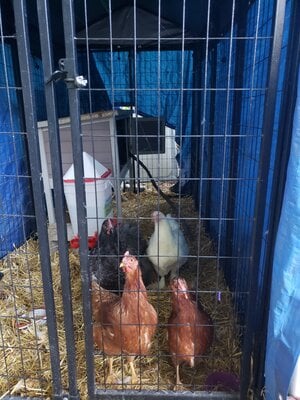JennM114
In the Brooder
- May 10, 2020
- 11
- 4
- 16
This will be my first winter as a chicken tender and we are gearing up the coop for winter. We live in northeast Illinois (Chicago suburbs) where winters can wildly vary between mild and practically arctic - most years, yo-yoing between both extremes several times each winter.
We have five hens that are all considered cold-hardy breeds in a walk-in 4'x8' open coop that is of steel construction (very similar to an outdoor dog kennel) with a smaller wooden enclosed coop (think bunny hutch) which are in an larger, free-range run area. We have securely covered the structure with tarp to block out drafts and hold in heat and have a de-icer for their waterer. I've read everything I can get my hands on, but am left with a few questions.
First, does anyone from IL (or anywhere with similar winters) have advice/recommendations about using a coop heater? Some resources say they are a necessity, while others say that with cold-hardy breeds you dont need one. If they are not necessary for my flock, are there any dangers in still using one? For example, asumming the heater is a good brand and installed correctly; do they pose a significant fire risk? Can the chickens suffer burns if they touch it or roost too close?
Second; we have the de-icer for their water, but how do we keep their food from freezing solid? I could find nothing even referencing this.
Third; We've been able to successfully mitigate predator risk, so far, by having an sort of floor on the larger coop dug into the ground. Nothing can dig it's way in or out. And after a close call with a mink wiggling through the bars, We also surrounded the lower 2 feet in chicken wire. However, we *have* seen a few mink, raccoons, and even one coyote approach the coop at night on our trail cams. Right now they give up and move on pretty quickly. I assuming that with winters reduced resources, these predators will become more agressive in trying to gain access to our lovely, plump girls. Is there anything else we should be doing to protect them?
Finally, our girls currently enjoy several hours of free ranging every day. How do we safely keep that up when the ground freezes and the snow comes? Or *should* we keep it up?
If I've missed anything, any additional advice would be most welcome!
Thanks!
We have five hens that are all considered cold-hardy breeds in a walk-in 4'x8' open coop that is of steel construction (very similar to an outdoor dog kennel) with a smaller wooden enclosed coop (think bunny hutch) which are in an larger, free-range run area. We have securely covered the structure with tarp to block out drafts and hold in heat and have a de-icer for their waterer. I've read everything I can get my hands on, but am left with a few questions.
First, does anyone from IL (or anywhere with similar winters) have advice/recommendations about using a coop heater? Some resources say they are a necessity, while others say that with cold-hardy breeds you dont need one. If they are not necessary for my flock, are there any dangers in still using one? For example, asumming the heater is a good brand and installed correctly; do they pose a significant fire risk? Can the chickens suffer burns if they touch it or roost too close?
Second; we have the de-icer for their water, but how do we keep their food from freezing solid? I could find nothing even referencing this.
Third; We've been able to successfully mitigate predator risk, so far, by having an sort of floor on the larger coop dug into the ground. Nothing can dig it's way in or out. And after a close call with a mink wiggling through the bars, We also surrounded the lower 2 feet in chicken wire. However, we *have* seen a few mink, raccoons, and even one coyote approach the coop at night on our trail cams. Right now they give up and move on pretty quickly. I assuming that with winters reduced resources, these predators will become more agressive in trying to gain access to our lovely, plump girls. Is there anything else we should be doing to protect them?
Finally, our girls currently enjoy several hours of free ranging every day. How do we safely keep that up when the ground freezes and the snow comes? Or *should* we keep it up?
If I've missed anything, any additional advice would be most welcome!
Thanks!





